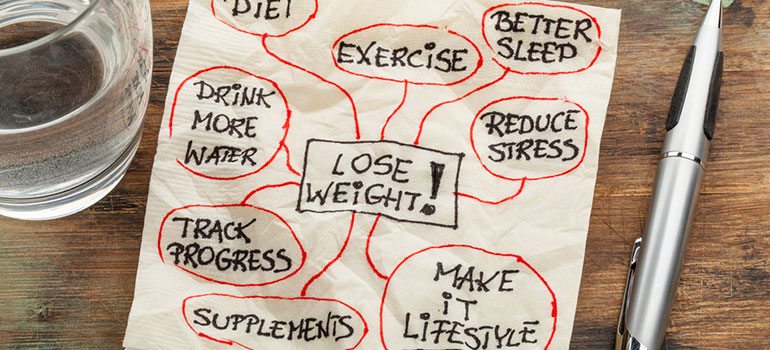
The Psychology of Weight Loss
Less than 20% of American women are genuinely satisfied with the way their bodies look. This may be due to the fact that over the years, several influences have dictated to them over and over that they should look, dress and act a certain way.
The diet and weight loss statistics in our country show an alarming trend. 92% of girls under the age of eighteen have gone on more than one diet in a bid to lose weight quickly.
While weight loss in and of itself is not a bad thing, the unhealthy fixation of our minds on it is. Our perceived imperfections can cause us to not only have low self-esteem but also forget to enjoy our lives.
Moving away from the dieting mindset is a very good place to start restructuring your life from. After moving away from the dieting mindset, your goal should be to restructure your life to be the healthiest and best version of you (because let’s face it not everyone can be a size 0) possible.

Why Weight Loss Should Not Be Your Goal
A healthy weight is a byproduct of healthy living. So your goal should always be healthy living and never weight loss. Stop falling into the trap of fad diets that ask how many pounds you can lose in 7, 12 or 30 days. After all, you didn’t even gain the weight in 30 days.
Instead, start making small sustainable changes to your choices daily. The key to healthy living is sustainability.
While you might be tempted to go on a ketosis diet or severe calorie restrictions for a few weeks to lose some weight, keep in mind that a ketosis diet and severe calorie restriction is likely unsustainable in the long term.
Here are a few changes you can make in the space of four weeks that are sustainable.
WEEK 1: THE ELIMINATION WEEK
In the first week, eliminate all refined sugars. This means no soft drinks, pastries, sweets, fast food, snacks, some bread, soda, alcohol, juices, processed foods with sugar, etc.
Empty out your fridge and fill the resulting space with real food. Even better, you can draw up a weekly meal plan with no refined sugars and stick to it for one week.
The goal here is to get you started in eating real food. Just about every meal in fast foods has some sugar in it. So, go groceries shopping and start eating home cooked.
No drinks or juices of any kind are allowed in this week. You need to start drinking a minimum of 2 liters of water a day.
In addition to this, eliminate all foods which you do not tolerate well. Examples are lactose, gluten, etc.
WEEK 2: SWAPPING CARBOHYDRATES
Week 2 is all about swapping carbohydrates. This week, your aim is to reduce the amount of white or processed carbohydrates you eat.
White carbohydrates have a high glycemic index and will affect your insulin levels and energy. Some examples are white rice, white bread, pasta, etc.
So, your goal is to switch eighty percent of your white carbs for brown carbs by the end of the week. Start small and build from there.
Brown carbs are generally low glycemic index foods. They take a while to digest and will leave you feeling satiated for longer. They also do not affect insulin levels markedly. They include whole oats, brown rice, whole grain bread, quinoa, etc.
WEEK 3: VEGGIES, VEGGIES AND MORE VEGGIES
This week, your goal is to start eating more vegetables. I recommend a minimum of 5 servings of vegetable and one of fruit per day.
Stick to low carb vegetables and leave the starchier options for special occasions.
A good way to eat more veggies is to incorporate them into mealtimes and also use them as snacks. Eating salads and making smoothies for breakfast is also a very good way to do this.
Just eat the vegetables, people! They are really good for your health.
WEEK 4: MAINTENANCE
In this week, you goal is to calculate the calories you need to eat daily and rework your new diet to fit that number.
If you aim to eat 2000 calories a day in 3 meals and 2 snacks, then your meals should be about 550 calories each and your snacks should not exceed a combined total of 350 calories.
Maintenance is the most overlooked art of weight loss. It is also the most important. When you lose weight only to gain it back, your body gets confused and begins to panic store fat for future starvation.
So, don’t starve yourself. Instead, eat healthily.
In addition to this, start to work out regularly. If you are a beginner, start with gentle exercises and work your way up. Aim to lose 300 to 700 calories per workout session.
How to Overcome the Dieting Mindset
Because we have been raised with the mindset that some people are more beautiful than others, we all want to achieve that perfect toned body.
However, you must come to realize that healthy can look different from the norm. Your genes, upbringing and lifestyle play a major role in determining the state of your health.
Don’t beat yourself up because your body is not as thin, tan and toned as the other person.
Aim to be the best you can be. And that too is different for everybody.
Conclusion
Always keep in mind that a healthy body and a healthy mind are the vessels for fulfilling your purpose and enjoying life.
Instead of chasing after weight loss constantly, choose to live healthily.
The results will speak for themselves.









